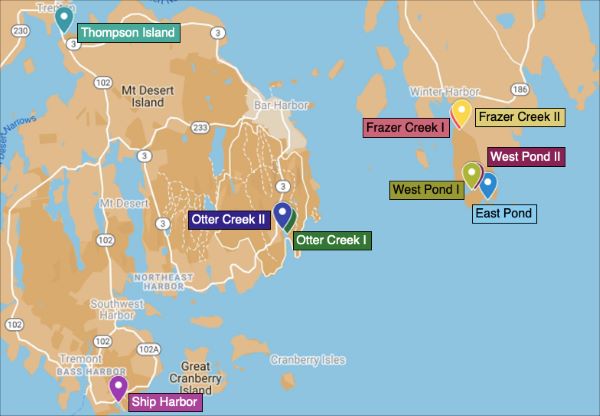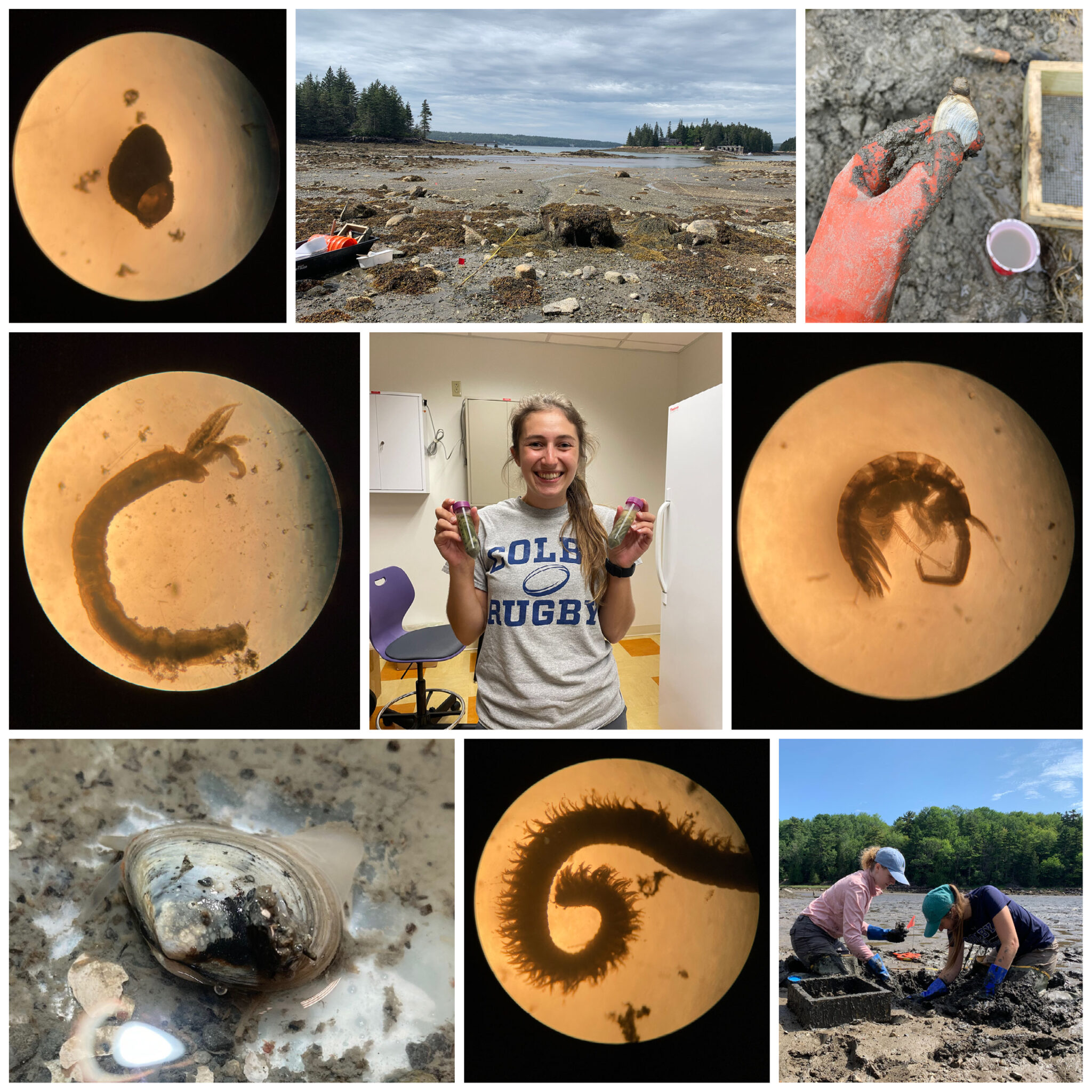story and images by Tessa Houston, 2021 Schoodic Institute Ecology Technician
The mudflats of Downeast Maine offer considerable value to the area, economically, culturally, and ecologically. According to the Maine Department of Marine Resources, in Hancock County alone, the soft-shell clam industry was valued at $2,559,825 in 2020 and the blood/sandworm industries combined were valued at $1,309,969. These mudflats are also culturally important, as clammers and wormers have been accessing them for generations. The Wabanaki people have been clamming in what is now called Maine for thousands of years; their place name for Bar Harbor, Moneskatik, means place where clams are dug. Ecologically, mudflats are important feeding grounds for migratory birds and finfish.
However, this ecosystem is also one of the least studied in Acadia National Park, with the most recent study published in 1992 by Leon Cammen and Peter Larsen, research scientists from Bigelow Laboratory for Ocean Sciences. In addition, the low-energy and fine-grained nature of mudflats make them susceptible to the accumulation of toxic substances, from near and far. As our environment becomes more and more polluted and shifts due to climate change, it is crucial to understand how our mudflats are being impacted by these factors over time.
During the summer of 2021, I sunk, quite literally, into the mudflats of Acadia National Park, along with Scientists-in-Parks intern Anna Lee, to continue the monitoring process started by Cammen and Larsen for the National Park Service in the 1980s, while also exploring the relationship between clams and other soft-sediment invertebrates (animals with no backbone).

Our methods were the same as in 1992 with a few modifications. We collected samples at nine sites on Schoodic Peninsula and Mount Desert Island which included two sites sampled historically (Thompson Island and Otter Creek) and seven sites that we chose in consultation with local wormers, clammers, and park law enforcement. At each site, we took eight sediment samples using two-inch PVC corers. We sieved the samples on-site and sorted through them for invertebrates in the lab at Schoodic Institute. In addition, we completed six clam surveys at each site, based on the survey methods recommended by the Maine Department of Marine Resources. In the lab, we stored the invertebrates in formalin, a chemical solution used to preserve an organism’s tissues, for at least 48 hours before identifying them to the lowest taxonomic level possible and preserving them in 70 percent ethanol. Samples will be stored in Acadia National Park’s archives.

Across the nine sites, we extracted and identified 2,696 marine invertebrates and surveyed 40 clams, including mostly soft-shell clams (Mya arenaria) as well as one razor clam (Ensis leei) and one amethyst gem clam (Gemma gemma). Preliminary data show a positive correlation between invertebrate species richness and clam abundance. While neither variable is necessarily dependent upon the other, it is possible that clam abundance could be used as an indicator for a site’s biodiversity, as more clams would mean higher biodiversity. It is much easier, relatively, to determine clam abundance than species richness, which involves a long lab process. I would also hypothesize that certain environmental factors such as sediment type and water quality could be influencing both abundance and richness. It’s possible that areas with better water quality create an environment conducive to higher species richness, as more species can survive in those conditions. Sediment type is something that we are currently attempting to characterize for this season’s samples, but it could also be enlightening to take a measure of water quality at each site in the future.
At the two sites sampled by Cammen and Larsen, we found many fewer species than the previous study. At Otter Creek, Cammen and Larsen found a total of 25 macroinvertebrate species while we sampled 3 species at that location. At Thompson Island, Cammen and Larsen found 48 species while we sampled only 17. This decrease in diversity could indicate that these important habitats have changed drastically since the 1980s, becoming less fit for many invertebrate species.
On a more personal note, going into this research, I had very little interest in, or knowledge of, marine worms. To me, they were always something to respectfully fear at the beach, avoiding the piles of sand left in their wake. Through this research, as cheesy as it sounds, I have made friends with the worms. The excitement that comes with seeing my favorite species, Streblospio benedicti, or mustache men as my coworker and I coined them, would probably be weird to others outside of the marine invertebrate world. I have learned so much about identifying these species and using the variety of resources available to me, while still acknowledging my limits. The application iNaturalist has been a huge help, allowing me to post images of unfamiliar worms and have a global community of scientists provide a recommendation on a family or species. Overall, I am excited to see where this project goes in the future, what changes are made, and how the macroinvertebrate populations of the mudflats of Acadia National Park will change over time.

Works Cited:
Cammen, L. M., and P. F. Larsen. 1992. An ecological characterization of intertidal resources of Acadia National Park: macrofauna. Boston, Massachusetts: United States. National Park Service. North Atlantic Region; Technical Report NPSINAROSSINRTR92/06. 47 pages.
History of Clamming. The Mudflat.
Landings Data Portal. Maine Department of Marine Resources.
Larsen, P. F., and L. F. Doggett (1991). The macroinvertebrate fauna associated with the mud flats of the Gulf of Maine. Journal of Coastal Research, 365-375.
Webber, M.M., M.G. Stocco, C. Schmitt, & K. Tenga-González. 2021. Maine Shellfish Handbook. Maine Department of Marine Resources. 90 pages.
